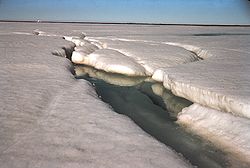
The Arctic Environmental Protection Strategy (AEPS) (sometimes referred to as the Finnish Initiative)[1] is a multilateral, non-binding agreement[2] among Arctic states on environmental protection in the Arctic. Discussions began in 1989, with the AEPS adopted in June 1991 by Canada, Denmark, Finland, Iceland, Norway, Sweden, the Soviet Union, and the United States. The AEPS deals with monitoring, assessment, protection, emergency preparedness/response, and conservation of the Arctic zone.[3] It has been called a major political accomplishment of the post–Cold War era.[4]
- ^ Cite error: The named reference
officewas invoked but never defined (see the help page). - ^ Russell, Bruce A. "The Arctic Environmental Protection Strategy & the New Arctic Council". Archived from the original on 11 October 2008. Retrieved 2008-09-23.
- ^ "The Arctic Environmental Protection Strategy". carc.org. Archived from the original on 2006-10-07. Retrieved 2008-09-23.
- ^ Broadus, J.M.; Vartanov, R.V., eds. (1994). The Oceans and Environmental Security: Shared Us and Russian Perspectives. Washington, D.C.: Island Press. pp. 176. ISBN 1-55963-235-6.
Arctic Environmental Protection Strategy .